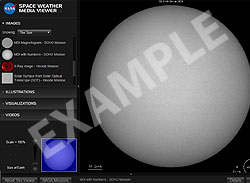National Aeronautics and Space Administration
Goddard Space Flight Center

Space Weather Action Center
Sunspot Regions
MDI with numbers Tutorial

Above: A sample image taken from the SOHO MDI. The above image is NOT live data.
Getting to the Data
The easiest way to view this image is by opening the Space Weather Media Viewer. In the "IMAGES" section select "The Sun" from the small drop-down menu. Select the image called, "MDI with Numbers- SOHO Mission". Don't forget to zoom in and pan to the top center of the image in order to see the exact date and time of the image.
About the Data
The MDI (Michelson Doppler Imager) produces images that appear most nearly as the Sun would look at sunrise or sunset. (Remember, don't ever look directly at the Sun.) The most prominent features are the sunspots. Each sunspot region is given a number by scientists to help them communicate better with each other.
"SOHO MDI with Numbers" shows black and white SOHO MDI images with sunspot numbers printed next to the sunspots. You should use these numbers when you refer to sunspots in your Space Weather reports.
Navigation Tips
- Zoom and Pan: With any image in the Space Weather Media Viewer you can zoom and pan. This feature allows you to see sunspots on the Sun in great detail along with the relative size of Earth. Some small sunspots may not be visible until you zoom. Also, you will find scale images of Earth and Jupiter in the lower right hand side of each "MDI with Numbers" image.
- Details: The box marked "Details" found in the lower right hand side of the Space Weather Media Viewer screen will provide additional information and a link to the Solar and Heliospheric Observatory website.
You are viewing a tutorial
Related Tutorials
- H-Alpha Full Disk Image of the Sun
- Atmospheric Imaging Assembly
- Large Angle and Spectrometric Coronagraph
The above tutorials compliment the downloadable Flip Charts and Data Sheets.
